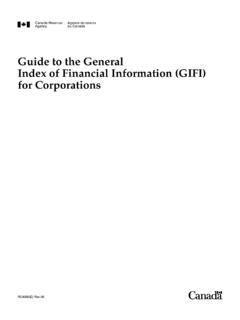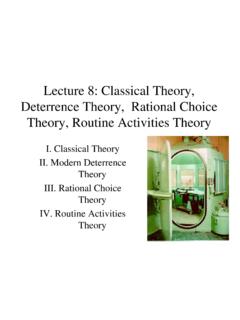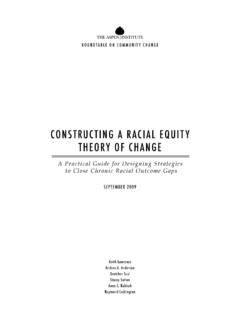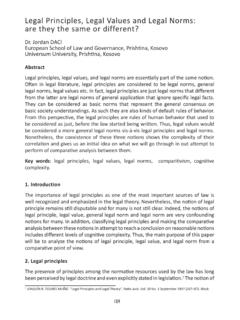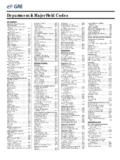Transcription of thirteen (13) identifiable types - New Learner
1 CRIME THEORIES The function of theory is to provide puzzles for research (Lewis Coser) Source: O'Connor, T. (03/26/04). In Crime Theories, MegaLinks in Criminal Justice. Retrieved from on January 9, 2006. To understand criminal justice, it is necessary to understand crime. Most policy-making in criminal justice is based on criminological theory, whether the people making those policies know it or not. In fact, most of the failed policies (what doesn't work) in criminal justice are due to misinterpretation, partial implementation, or ignorance of criminological theory. Much time and money could be saved if only policymakers had a thorough understanding of criminological theory.
2 At one time, criminological theory was rather pure and abstract, with few practical implications, but that is not the case anymore. For example, almost all criminologists today use a legalistic rather than normative definition of crime. A legalistic definition of crime takes as its starting point the statutory definitions contained in the penal code, legal statutes or ordinances. A crime is a crime because the law says so. Sure, there are concerns about overcriminalization (too many laws) and undercriminalization (not enough laws), but at least on the surface, a legalistic approach seems practical. It is also advantageous to a normative definition, which sees crime as a violation of norms (social standards of how humans ought to think and behave), although there are times when criminology can shed light on norms and norm violators.
3 Every criminological theory contains a set of assumptions (about human nature, social structure, and the principles of causation, to name a few), a description of the phenomena to be explained (facts a theory must fit), and an explanation, or prediction, of that phenomenon. The assumptions are also called meta-theoretical issues, and deal with debates like those over free will v. determinism or consensus v. conflict. The description is a statistical profile, figure, diagram, or table of numbers representing the patterns, trends, and correlates of the type of crime taken as an exemplar (most appropriate example) of all crime. The explanation is a set of variables (things that can be tweaked or changed) arranged in some kind of causal order so that they have statistical and meaningful significance.
4 Criminological theories are primarily concerned with etiology (the study of causes or reasons for crime), but occasionally have important things to say about actors in the criminal justice system, such as police, attorneys, correctional personnel, and victims. There are basically thirteen (13) identifiable types of criminological theory, only three (3) of which are considered "mainstream" or conventional criminology (strain, learning, control). The oldest theory (biochemistry) goes back to 1876 and the last four theories (left realism, peacemaking, feminist, postmodern) have only developed in the past twenty-five years. The following table illustrates, with more information about each theory below the table: Theory Causes Policy 1.
5 Biochemistry heredity, vitamin deficiency, allergy, tumor, toxins, brain dysfunction, hormonal imbalance isolation, treatment 2. Psychology low intelligence, psychopathy, stress treatment, counseling 3. Ecology disorganized neighborhoods community empowerment 4. Strain economic goal blockage increased opportunities 5. Learning imitation, reinforcement schedules more effective negative reinforcement, more use of positive reinforcement 6. Control socialization, low self-control child-rearing, social bonds 7. Labeling shunning, identity immersion nonintervention, reintegration 8. Conflict power differentials, competition increased equality 9.
6 Radical class struggle, capitalism praxis, socialism 10. Left Realism predatory relationships more effective police protection 11. Peacemaking inner suffering and turmoil spiritual rejuvenation 12. Feminist gender inequity, patriarchy end sex discrimination 13. Postmodern hierarchical privileges and language more informal social control 1. Biochemistry is known by many names: biological, constitutional (having to do with the structure of the body's morphology), genetic, and anthropological criminology. The oldest field is criminal anthropology, founded by the father of modern criminology, Cesare Lombroso, in 1876. He was one of the first exponents of the positivist approach to explaining crime, positivism meaning a search for the causes of crime using scientific method, as opposed to the classical approach, which relies upon free will as the main cause of crime.
7 Historically, theories of the biochemistry type have tried to establish the biological inferiority of criminals, but modern biocriminology simply says that heredity and body organ dysfunctions produce a predisposition toward crime. 2. Psychological criminology has been around since 1914, and attempts to explain the consistent finding that there is an eight-point IQ difference between criminals and noncriminals. That gap isn't enough to notice, but it might make them more impulsive and foolhardy, and even smart people with high IQs are vulnerable to folly. Other psychocriminologists focus on personality disorders, like the psychopaths, sociopaths, and antisocial personalities.
8 3. Ecological criminology was the first sociological criminology, developed during the 1920s at the Department of Sociology at the University of Chicago. Hence, it is also called Chicago School sociology. Ecology is the study of relationships between an organism and its environment, and this type of theory explains crime by the disorganized eco-areas where people live rather than by the kind of people who live there. 4. Strain, sometimes called by the French word anomie, is a 1938 American version of French sociology, invented by the father of modern sociology, Emile Durkheim (1858-1917). This type of theory sees crime as the normal result of an "American dream" in which people set their aspirations (for wealth, education, occupation, any status symbol) too high, and inevitably discover strain, or goal blockages, along the way.
9 The only two things to do are reduce aspirations or increase opportunities. 5. Learning theories tend to follow the lead of Edwin Sutherland's theory of differential association, developed in 1947, although ideas about imitation or modeling go back to 1890. Often oversimplified as "peer group" theories, learning is much more than that, and involves the analysis of what is positively and negatively rewarding (reinforcing) for individuals. 6. Control theories in criminology are all about social control. Only those called containment or low-self control theories have to do with individual psychology. Control theory has pretty much dominated the criminological landscape since 1969.
10 It focuses upon a person's relationships to their agents of socialization, such as parents, teachers, preachers, coaches, scout leaders, or police officers. It studies how effective bonding with such authority figures translates into bonding with society, hence keeping people out of trouble with the law. 7. Labeling theory was a child of the 1960s and 1970s which saw criminals as underdogs who initially did something out of the ordinary, and then got swept up in a huge, government-sponsored labeling or shunning reaction. It argues that anyone facing such an overwhelming, negative labeling social reaction will eventually become more like the label because that is the only way out for their identify formation.

